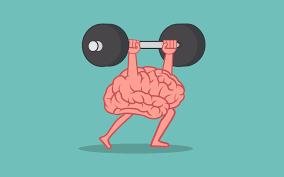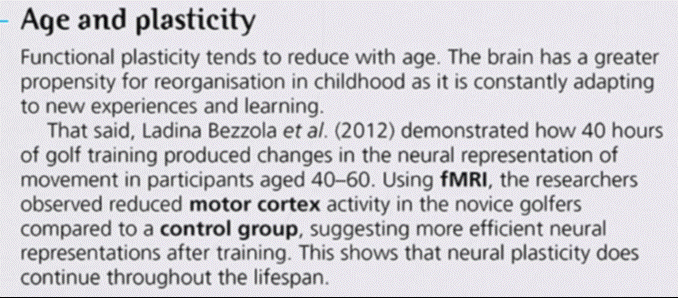Your previous lessons on the brain and your understanding of it so far has been that there are certain areas of the brain that are responsible for certain functions. So much so that when that area is damage either due to external trauma (hitting their head on something) or internal trauma (a stroke), that function is lost or hindered in some way.
You might remember from evaluating localisation of the brain, the theory of plasticity which differs from localisation of the brain and highlights the problems some psychologists have with using this explanation for how our biology affects human behaviour. For the purpose of the exam you need to know about the theory of plasticity and how functional recovery is an example of this, as you could get a 16 marker on it. However, you should have begun to notice how you can use the different theories of the brain to evaluate the others- therefore a better understanding of this will provide you with the knowledge to evaluate localisation more effectively using more issues and debates as your basis.
So, what actually is plasticity?
Plasticity is the brains ability to change an adapt as a result of damage, experiences and new learning.
During infancy the brain grows in the number of synaptic connections (peaks to 15 000 by 3 years old- ish). This is twice as many as in the adult brain. As we age, rarely used connections are deleted and frequently used connections are strengthened, this is called synaptic pruning.

According to plasticity, your brain essentially works like a muscle, the more the brain does something the stronger that action, function, behaviour or memory gets. It basically means the connections in your brain get stronger and faster and in some instances parts of your brain will get bigger. Likewise, if you don’t do something often- like revise your psychology knowledge- then your brain will become weaker at doing that and it will be harder to do.
Originally it was thought that changes were restricted to developing the brain within childhood and that the adult brain, having moved beyond a critical period, would remain fixed and static in terms of function and structure. However, more recent research suggests that at any time in life existing neural connections can change and new ones can be formed as a result of learning and the environment. The brain can change and adapt as a result of new experiences and new learning, and is not predetermined/ innate as previously suggested by other explanations (Localisation to name one!).
Blakemore and Cooper (1970) demonstrated neuroplasticity in cats, see the video below;
Video of Blakemore and Cooper Study
Tutor2u Description of Blakemore and Cooper study
Two examples of research that demonstrates this is Maguire (2000) & Draganski (2006).
Click here for the full Draganski research article to read!
Click here for the full Maguire research article to read!
DRAGANSKI (2006)
Aim: Does extensive learning induce structural changes in the cortex of brains and are these changes long or short term?
Method:
Sample: 38 medical students & 12 control students
MRI Scans of the brain were taken 3 months before medical exams, on the 1st or 2nd day of the exam and 23 of the participants had a scan 3 months later.
Result: significant increase in the grey matter of the Posterior Parietal Cortex of the medical students during the exam period and remained. Increase in posterior hippocampus, which continued increasing even after the learning period had ceased.
Conclusion: This research provides support that plasticity can occur as a result of changes within the environment to help cope with these kinds of changes.
Maguire (2000)
Aim: To find out if there was a difference in the brain scans of taxi drivers (with extensive spatial knowledge) compared to a control group of non taxi drivers.
Method:
-16 Right handed licensed London taxi drivers & 50 non taxi driving right handed males.
IV- Taxi driver or not Taxi driver
DV- MRI Scans were taken, analysed and compared
Results:
No differences in the overall volume of Hippocampus, but the Anterior Hippocampal Volume was bigger in the control group and the Posterior Hippocampal Volume bigger in Taxi Drivers. It was also found that the amount of time as a Taxi Driver was positively correlated with the volume of the Posterior Hippocampus.
Conclusion:
Provides evidence of regional plasticity (restructuring) in the brain of a healthy adult as a result of extensive learning and environmental stimulus
Functional Recovery
After physical injury or trauma (stroke), unaffected areas of the brain are able to adapt and compensate for damaged areas. Functional recovery that may occur in the brain after trauma is an example of plasticity. Healthy brain areas may take over functions of those that are damaged . Neuroscientists say this can happen very quickly (spontaneous recovery) but can then slow down which is when a patient may need rehabilitation to help encourage the functional recovery along.
video about a girl who had half her brain removed
What has happened to the girl in the video above is essentially functional recovery. Below is 3 examples of how the brain adapts to compensate for the damage that has occurred in the brain. I would recommend you know about all of these so you could use them to describe how function recovery happens.
Axonal sprouting– growth of new nerve endings which connect with undamaged nerve cells to form new neural pathways
Reformation of blood vessels- facilitates the growth of new neural pathways
Recruitment of homologous areas- where an area has been damaged the opposite side of the brain may take on those abilities
Evaluation of Plasticity and Function Recovery
Scientific credibility for plasticity- Research from Maguire and Draganski (mentioned earlier) support the idea that the structure of our brains can change and adapt to the environmental pressures it is put under. This is still classed as nature, as it is still the anatomical structure that is causes the changes in our behaviour, however you could definitely mention that it contributes towards the nature vs nurture debate and suggests a more varied interactionist approach is adopted when thinking about human behaviour.
Case studies give credibility to functional recovery- The case study of Jodie suggests that our brains do change and adapt to cope with the damage and loss of function caused from removing parts of the brain. You could also bring in that this suggests this is a more holistic explanation of how our brains affect our behaviour compared to Localisation theory which suggests that all function would be lost.
Practical application to education-

How does this support Plasticity?
Practical application of the findings to the field of neurorehabilitation-Understanding the processes of plasticity and functional recovery led to the development of neurorehabilitation which uses motor therapy and electrical stimulation of the brain to counter the negative effects and deficits in motor and cognitive functions following accidents, injuries and/or strokes. This demonstrates the positive application of research in this area to help improve the cognitive functions of people suffering from injuries.
Dispute over age and plasticity. Some evidence argues that the older you are the less plasticity your brain can do:
Marquez da la Plata et al (2008)
Following brain trauma, older patients (40+ years old) regained less function in treatments than younger patients. They were also more likely to decline in terms of function for the 5 years following the trauma.
However, the following research says otherwise. Potentially, individual differences play more of a part in plasticity than the theory gives credit too. Suggesting that there may be more to the explanation that it gives.

